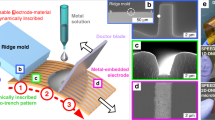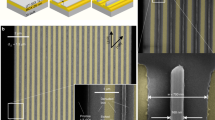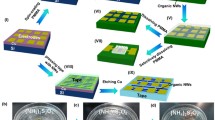Abstract
Bottom-up synthesis of semiconductor nanowires (NWs) by the vapor-liquid-solid (VLS) mechanism has enabled diverse technological applications for these nanomaterials. Unlike metallic NWs, however, it has been challenging to form large-area interconnected NW networks. Here, we generate centimeter-scale meshes of mechanically and electrically interconnected Si NWs by sequentially growing, collapsing, and joining the NWs using a capillarity-driven welding mechanism. We fabricate meshes from VLS-grown NWs ranging in diameter from 20 to 100 nm and find that the meshes are three-dimensional with a thickness ranging from ~ 1 to ~ 10 microns depending on the NW diameter. Optical extinction measurements reveal that the networks are semi-transparent with a color that depends on the absorption and scattering characteristics of individual NWs. Moreover, active voltage contrast imaging of both centimeter- and micron-scale meshes reveals widespread electrical connectivity. Using a sacrificial layer, we demonstrate that the mesh can be liberated from the growth substrate, yielding a highly flexible and transparent film. Electrical transport measurements both on the growth substrate and on liberated, flexible films reveal electrical conduction across a centimeter scale with a sheet resistance of ~ 160–180 kΩ/square that does not change significantly upon bending. Given the ability to encode complex functionality in semiconductor NWs through the VLS process, we believe these meshes of networked NWs could find application as neuromorphic memory, electrode scaffolds, and bioelectronic interfaces.
Similar content being viewed by others
References
Lieber, C. M. Semiconductor nanowires: A platform for nanoscience and nanotechnology. MRS Bull.2011, 36, 1052–1063.
Zhang, A. Q.; Zheng, G. F.; Lieber, C. M. Nanowires: Building Blocks for Nanoscience and Nanotechnology; Springer: Cham, 2016.
Tian, B. Z.; Cohen-Karni, T.; Qing, Q.; Duan, X. J.; Xie, P.; Lieber, C. M. Three-dimensional, flexible nanoscale field-effect transistors as localized bioprobes. Science2010, 329, 830–834.
Chan, C. K.; Peng, H. L.; Liu, G.; McIlwrath, K.; Zhang, X. F.; Huggins, R. A.; Cui, Y. High-performance lithium battery anodes using silicon nanowires. Nat. Nanotechnol.2008, 3, 31–35.
Takei, K.; Takahashi, T.; Ho, J. C.; Ko, H.; Gillies, A. G.; Leu, P. W.; Fearing, R. S.; Javey, A. Nanowire active-matrix circuitry for low-voltage macroscale artificial skin. Nat. Mater.2010, 9, 821–826.
Garg, R.; Rastogi, S. K.; Lamparski, M.; de la Barrera, S. C.; Pace, G. T.; Nuhfer, N. T.; Hunt, B. M.; Meunier, V.; Cohen-Karni, T. Nanowire-mesh-templated growth of out-of-plane three-dimensional fuzzy graphene. ACS Nano2017, 11, 6301–6311.
Sandler, J. K. W.; Kirk, J. E.; Kinloch, I. A.; Shaffer, M. S. P.; Windle, A. H. Ultra-low electrical percolation threshold in carbon-nanotube-epoxy composites. Polymer2003, 44, 5893–5899.
De, S.; Higgins, T. M.; Lyons, P. E.; Doherty, E. M.; Nirmalraj, P. N.; Blau, W. J.; Boland, J. J.; Coleman, J. N. Silver nanowire networks as flexible, transparent, conducting films: Extremely high DC to optical conductivity ratios. ACS Nano2009, 3, 1767–1774.
Hu, L. B.; Kim, H. S.; Lee, J. Y.; Peumans, P.; Cui, Y. Scalable coating and properties of transparent, flexible, silver nanowire electrodes. ACS Nano2010, 4, 2955–2963.
Lyons, P. E.; De, S.; Elias, J.; Schamel, M.; Philippe, L.; Bellew, A. T.; Boland, J. J.; Coleman, J. N. High-performance transparent conductors from networks of gold nanowires. J. Phys. Chem. Lett.2011, 2, 3058–3062.
Rathmell, A. R.; Wiley, B. J. The synthesis and coating of long, thin copper nanowires to make flexible, transparent conducting films on plastic substrates. Adv. Mater.2011, 23, 4798–4803.
Rabbani, M. G.; Patil, S. R.; Verma, A.; Villarreal, J. E.; Korgel, B. A.; Nekovei, R.; Khader, M. M.; Darling, R. B.; Anantram, M. P. Zero-bias photocurrents in highly-disordered networks of Ge and Si nanowires. Nanotechnology2016, 27, 045201.
Hossain, M.; Kumar, G. S.; Barimar Prabhava, S. N.; Sheerin, E. D.; McCloskey, D.; Acharya, S.; Rao, K. D. M.; Boland, J. J. Transparent, flexible silicon nanostructured wire networks with seamless junctions for high-performance photodetector applications. ACS Nano2018, 12, 4727–4735.
Cui, Y.; Wei, Q. Q.; Park, H.; Lieber, C. M. Nanowire nanosensors for highly sensitive and selective detection of biological and chemical species. Science2001, 293, 1289–1292.
Kempa, T. J.; Tian, B. Z.; Kim, D. R.; Hu, J. S.; Zheng, X. L.; Lieber, C. M. Single and tandem axial p-i-n nanowire photovoltaic devices. Nano Lett.2008, 8, 3456–3460.
Hill, D. J.; Teitsworth, T. S.; Ritchie, E. T.; Atkin, J. M.; Cahoon, J. F. Interplay of surface recombination and diode geometry for the performance of axial p-i-n nanowire solar cells. ACS Nano2018, 12, 10554–10563.
Christesen, J. D.; Pinion, C. W.; Grumstrup, E. M.; Papanikolas, J. M.; Cahoon, J. F. Synthetically encoding 10 nm morphology in silicon nanowires. Nano Lett.2013, 13, 6281–6286.
Wang, D. L.; Qian, F.; Yang, C.; Zhong, Z. H.; Lieber, C. M. Rational growth of branched and hyperbranched nanowire structures. Nano Lett.2004, 4, 871–874.
Grebinski, J. W.; Hull, K. L.; Zhang, J.; Kosel, T. H.; Kuno, M. Solution-based straight and branched CdSe nanowires. Chem. Mater.2004, 16, 5260–5272.
Zhu, J.; Peng, H. L.; Chan, C. K.; Jarausch, K.; Zhang, X. F.; Cui, Y. Hyperbranched lead selenide nanowire networks. Nano Lett.2007, 7, 1095–1099.
Jiang, X. C.; Tian, B. Z.; Xiang, J.; Qian, F.; Zheng, G. F.; Wang, H. T.; Mai, L. Q.; Lieber, C. M. Rational growth of branched nanowire heterostructures with synthetically encoded properties and function. Proc. Natl. Acad. Sci. USA2011, 108, 12212–12216.
Plissard, S. R.; van Weperen, I.; Car, D.; Verheijen, M. A.; Immink, G. W. G.; Kammhuber, J.; Cornelissen, L. J.; Szombati, D. B.; Geresdi, A.; Frolov, S. M. et al. Formation and electronic properties of InSb nanocrosses. Nat. Nanotechnol.2013, 8, 859–864.
Car, D.; Wang, J.; Verheijen, M. A.; Bakkers, E. P. A. M.; Plissard, S. R. Rationally designed single-crystalline nanowire networks. Adv. Mater.2014, 26, 4875–4879.
Dalacu, D.; Kam, A.; Austing, D. G.; Poole, P. J. Droplet dynamics in controlled InAs nanowire interconnections. Nano Lett.2013, 13, 2676–2681.
Rieger, T.; Rosenbach, D.; Vakulov, D.; Heedt, S.; Schäpers, T.; Grützmacher, D.; Lepsa, M. I. Crystal phase transformation in self-assembled InAs nanowire junctions on patterned Si substrates. Nano Lett.2016, 16, 1933–1941.
Beaudry, A. L.; LaForge, J. M.; Tucker, R. T.; Sorge, J. B.; Adamski, N. L.; Li, P.; Taschuk, M. T.; Brett, M. J. Directed branch growth in aligned nanowire arrays. Nano Lett.2014, 14, 1797–1803.
Celano, T. A.; Hill, D. J.; Zhang, X.; Pinion, C. W.; Christesen, J. D.; Flynn, C. J.; McBride, J. R.; Cahoon, J. F. Capillarity-driven welding of semiconductor nanowires for crystalline and electrically ohmic junctions. Nano Lett.2016, 16, 5241–5246.
Gere, J. M.; Timoshenko, S. P. Mechanics of Materials; 4th ed. PWS Publish Company: Boston, 1997.
Tada, M.; Park, J. H.; Kuzum, D.; Thareja, G.; Jain, J. R.; Nishi, Y.; Saraswat, K. C. Low temperature germanium growth on silicon oxide using boron seed layer and in situ dopant activation. J. Electrochem. Soc.2010, 157, H371–H376.
Cao, L. Y.; Fan, P. Y.; Barnard, E. S.; Brown, A. M.; Brongersma, M. L. Tuning the color of silicon nanostructures. Nano Lett.2010, 10, 2649–2654.
Bao, H.; Zhang, W. X.; Chen, L. L.; Huang, H. X.; Yang, C.; Ruan, X. L. An investigation of the optical properties of disordered silicon nanowire mats. J. Appl. Phys.2012, 112, 124301.
Holmberg, V. C.; Bogart, T. D.; Chockla, A. M.; Hessel, C. M.; Korgel, B. A. Optical properties of silicon and germanium nanowire fabric. J. Phys. Chem. C2012, 116, 22486–22491.
Rosenkranz, R. Failure localization with active and passive voltage contrast in FIB and SEM. J. Mater. Sci.: Mater. Electron.2011, 22, 1523–1535.
Fairfield, J. A.; Ritter, C.; Bellew, A. T.; McCarthy, E. K.; Ferreira, M. S.; Boland, J. J. Effective electrode length enhances electrical activation of nanowire networks: Experiment and simulation. ACS Nano2014, 8, 9542–9549.
Sabate, A. C.; Ismail, N.; Nordin, N. Innovative way of implementing active voltage contrast. In Proceedings of the 20th IEEE International Symposium on the Physical and Failure Analysis of Integrated Circuits, Suzhou, 2013, pp 132–135.
Nirmalraj, P. N.; Bellew, A. T.; Bell, A. P.; Fairfield, J. A.; McCarthy, E. K.; O’Kelly, C.; Pereira, L. F. C.; Sorel, S.; Morosan, D.; Coleman, J. N. et al. Manipulating connectivity and electrical conductivity in metallic nanowire networks. Nano Lett.2012, 12, 5966–5971.
De, S.; King, P. J.; Lyons, P. E.; Khan, U.; Coleman, J. N. Size effects and the problem with percolation in nanostructured transparent conductors. ACS Nano2010, 4, 7064–7072.
Balberg, I.; Binenbaum, N. Computer study of the percolation threshold in a two-dimensional anisotropic system of conducting sticks. Phys. Rev. B1983, 28, 3799–3812.
Hu, L.; Hecht, D. S.; Grüner, G. Percolation in transparent and conducting carbon nanotube networks. Nano Lett.2004, 4, 2513–2517.
Yang, L. Q.; Zhang, T.; Zhou, H. X.; Price, S. C.; Wiley, B. J.; You, W. Solution-processed flexible polymer solar cells with silver nanowire electrodes. ACS Appl. Mater. Interfaces2011, 3, 4075–4084.
Xie, C.; Liu, J.; Fu, T. M.; Dai, X. C.; Zhou, W.; Lieber, C. M. Three-dimensional macroporous nanoelectronic networks as minimally invasive brain probes. Nat. Mater.2015, 14, 1286–1292.
Acarón Ledesma, H.; Li, X. J.; Carvalho-de-Souza, J. L.; Wei, W.; Bezanilla, F.; Tian, B. Z. An atlas of nano-enabled neural interfaces. Nat. Nanotechnol.2019, 14, 645–657.
Thomas, A. Memristor-based neural networks. J. Phys. D: Appl. Phys.2013, 46, 093001.
DeFelipe, J.; Marco, P.; Busturia, I.; Merchán-Pérez, A. Estimation of the number of synapses in the cerebral cortex: Methodological considerations. Cereb. Cortex1999, 9, 722–732.
Pinion, C. W.; Nenon, D. P.; Christesen, J. D.; Cahoon, J. F. Identifying crystallization- and incorporation-limited regimes during vapor-liquid-solid growth of Si nanowires. ACS Nano2014, 8, 6081–6088.
Acknowledgements
This research was supported by the National Science Foundation (NSF) through grant DMR-1555001. S. K. acknowledges a Kwanjeong Scholarship, J. F. C. acknowledges a Packard Fellowship for Science and Engineering, and D. J. H. acknowledges an NSF graduate research fellowship. This work made use of instrumentation at the Chapel Hill Analytical and Nanofabrication Laboratory (CHANL), a member of the North Carolina Research Triangle Nanotechnology Network (RTNN), which is supported by the NSF (No. ECCS-1542015) as part of the National Nanotechnology Coordinated Infrastructure (NNCI).
Author information
Authors and Affiliations
Corresponding author
Additional information
Notes
The authors declare no competing financial interest.
Rights and permissions
About this article
Cite this article
Celano, T.A., Kim, S., Hill, D.J. et al. Semi-transparent, flexible, and electrically conductive silicon mesh by capillarity-driven welding of vapor-liquid-solid-grown nanowires over large areas. Nano Res. 13, 1465–1471 (2020). https://doi.org/10.1007/s12274-020-2742-8
Received:
Revised:
Accepted:
Published:
Issue Date:
DOI: https://doi.org/10.1007/s12274-020-2742-8




